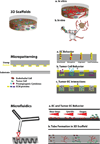Engineering approaches for investigating tumor angiogenesis: exploiting the role of the extracellular matrix
- PMID: 23172313
- PMCID: PMC3513494
- DOI: 10.1158/0008-5472.CAN-12-2773
Engineering approaches for investigating tumor angiogenesis: exploiting the role of the extracellular matrix
Abstract
A major paradigm shift in cancer research is the emergence of multidisciplinary approaches to investigate complex cell behaviors, to elucidate regulatory mechanisms and to identify therapeutic targets. Recently, efforts are focused on the engineering of complex in vitro models, which more accurately recapitulate the growth and progression of cancer. These strategies have proven vital for investigating and targeting the events that control tumor angiogenesis. In this review, we explore how the emerging engineering approaches are being used to unlock the complex mechanisms regulating tumor angiogenesis. Emphasis is placed on models using natural and synthetic biomaterials to generate scaffolds mimicking the extracellular matrix, which is known to play a critical role in angiogenesis. While the models presented in this review are revolutionary, improvements are still necessary and concepts for advancing and perfecting engineering approaches for modeling tumor angiogenesis are proposed. Overall, the marriage between disparate scientific fields is expected to yield significant improvements in our understanding and treatment of cancer.
Conflict of interest statement
Figures

Similar articles
-
Tissue-engineered three-dimensional tumor models to study tumor angiogenesis.Tissue Eng Part A. 2010 Jul;16(7):2147-52. doi: 10.1089/ten.tea.2009.0668. Tissue Eng Part A. 2010. PMID: 20214471 Free PMC article. Review.
-
New dimensions in vascular engineering: opportunities for cancer biology.Tissue Eng Part A. 2010 Jul;16(7):2157-9. doi: 10.1089/ten.TEA.2010.0183. Tissue Eng Part A. 2010. PMID: 20367255 Free PMC article.
-
In vitro models of tumor vessels and matrix: engineering approaches to investigate transport limitations and drug delivery in cancer.Adv Drug Deliv Rev. 2014 Apr;69-70:205-216. doi: 10.1016/j.addr.2013.11.011. Epub 2013 Dec 2. Adv Drug Deliv Rev. 2014. PMID: 24309015 Free PMC article. Review.
-
Modeling the tumor extracellular matrix: Tissue engineering tools repurposed towards new frontiers in cancer biology.J Biomech. 2014 Jun 27;47(9):1969-78. doi: 10.1016/j.jbiomech.2013.09.029. Epub 2013 Oct 9. J Biomech. 2014. PMID: 24300038 Review.
-
Porcine arterial ECM hydrogel: Designing an in vitro angiogenesis model for long-term high-throughput research.FASEB J. 2020 Jun;34(6):7745-7758. doi: 10.1096/fj.202000264. Epub 2020 Apr 26. FASEB J. 2020. PMID: 32337805
Cited by
-
Implantable tissue isolation chambers for analyzing tumor dynamics in vivo.Lab Chip. 2016 May 21;16(10):1840-51. doi: 10.1039/c6lc00237d. Epub 2016 Apr 29. Lab Chip. 2016. PMID: 27128791 Free PMC article.
-
Tissue-engineered models of human tumors for cancer research.Expert Opin Drug Discov. 2015 Mar;10(3):257-68. doi: 10.1517/17460441.2015.1009442. Epub 2015 Feb 7. Expert Opin Drug Discov. 2015. PMID: 25662589 Free PMC article. Review.
-
Hydrogels to model 3D in vitro microenvironment of tumor vascularization.Adv Drug Deliv Rev. 2014 Dec 15;79-80:19-29. doi: 10.1016/j.addr.2014.06.002. Epub 2014 Jun 23. Adv Drug Deliv Rev. 2014. PMID: 24969477 Free PMC article. Review.
-
Bioinspired Hydrogels to Engineer Cancer Microenvironments.Annu Rev Biomed Eng. 2017 Jun 21;19:109-133. doi: 10.1146/annurev-bioeng-071516-044619. Annu Rev Biomed Eng. 2017. PMID: 28633560 Free PMC article. Review.
-
Tumour-on-a-chip: microfluidic models of tumour morphology, growth and microenvironment.J R Soc Interface. 2017 Jun;14(131):20170137. doi: 10.1098/rsif.2017.0137. J R Soc Interface. 2017. PMID: 28637915 Free PMC article. Review.
References
-
- Carmeliet P. Mechanisms of angiogenesis and arteriogenesis. Nat Med. 2000;6:389–395. - PubMed
-
- Folkman J. Tumor angiogenesis: therapeutic implications. N Engl J Med. 1971;285:1182–1186. - PubMed
-
- Chen G, Ushida T, Tateishi T. Scaffold Design for Tissue Engineering. Macromolecular Bioscience. 2002;2:67–75.
Publication types
MeSH terms
Grants and funding
LinkOut - more resources
Full Text Sources

